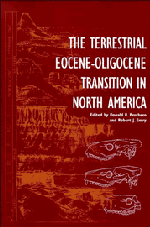Book contents
- Frontmatter
- Contents
- Contributors
- Preface
- PART I The Chronostratigraphy of the Uintan through Arikareean
- 1 Magnetic stratigraphy and biostratigraphy of the middle Eocene Uinta Formation, Uinta Basin, Utah
- 2 Biostratigraphy and magnetostratigraphy of the Bridgerian-Uintan Washakie Formation, Washakie Basin, Wyoming
- 3 Magnetic stratigraphy, sedimentology, and mammalian faunas of the early Uintan Washakie Formation, Sand Wash Basin, northwestern Colorado
- 4 Theoretical biochronology, the Bridgerian-Uintan boundary and the “Shoshonian Subage” of the Uintan
- 5 Middle Eocene mammalian faunas of San Diego County, California
- 6 Stratigraphy and paleomagnetism of the middle Eocene Friars Formation and Poway Group, southwestern San Diego County, California
- 7 Magnetostratigraphy of the upper middle Eocene Coldwater Sandstone, central Ventura County, California
- 8 Stratigraphy and paleomagnetism of the upper middle Eocene to lower Miocene (Uintan to Arikareean) Sespe Formation, Ventura County, California
- 9 Magnetostratigraphy of the Eocene-Oligocene transition in Trans-Pecos Texas
- 10 Magnetic stratigraphy of the Duchesnean part of the Galisteo Formation, New Mexico
- 11 Stratigraphy and vertebrate faunas of the Bridgerian-Duchesnean Clarno Formation, north-central Oregon
- 12 Eocene-Oligocene faunas of the Cypress Hills Formation, Saskatchewan
- 13 Magnetic stratigraphy of the White River Group in the High Plains
- 14 Magnetostratigraphy and biostratigraphy of the Eocene-Oligocene transition, southwestern Montana
- 15 The Whitneyan-Arikareean transition in the High Plains
- PART II Common Vertebrates of the White River Chronofauna
- Summary
- Index
9 - Magnetostratigraphy of the Eocene-Oligocene transition in Trans-Pecos Texas
Published online by Cambridge University Press: 06 July 2010
- Frontmatter
- Contents
- Contributors
- Preface
- PART I The Chronostratigraphy of the Uintan through Arikareean
- 1 Magnetic stratigraphy and biostratigraphy of the middle Eocene Uinta Formation, Uinta Basin, Utah
- 2 Biostratigraphy and magnetostratigraphy of the Bridgerian-Uintan Washakie Formation, Washakie Basin, Wyoming
- 3 Magnetic stratigraphy, sedimentology, and mammalian faunas of the early Uintan Washakie Formation, Sand Wash Basin, northwestern Colorado
- 4 Theoretical biochronology, the Bridgerian-Uintan boundary and the “Shoshonian Subage” of the Uintan
- 5 Middle Eocene mammalian faunas of San Diego County, California
- 6 Stratigraphy and paleomagnetism of the middle Eocene Friars Formation and Poway Group, southwestern San Diego County, California
- 7 Magnetostratigraphy of the upper middle Eocene Coldwater Sandstone, central Ventura County, California
- 8 Stratigraphy and paleomagnetism of the upper middle Eocene to lower Miocene (Uintan to Arikareean) Sespe Formation, Ventura County, California
- 9 Magnetostratigraphy of the Eocene-Oligocene transition in Trans-Pecos Texas
- 10 Magnetic stratigraphy of the Duchesnean part of the Galisteo Formation, New Mexico
- 11 Stratigraphy and vertebrate faunas of the Bridgerian-Duchesnean Clarno Formation, north-central Oregon
- 12 Eocene-Oligocene faunas of the Cypress Hills Formation, Saskatchewan
- 13 Magnetic stratigraphy of the White River Group in the High Plains
- 14 Magnetostratigraphy and biostratigraphy of the Eocene-Oligocene transition, southwestern Montana
- 15 The Whitneyan-Arikareean transition in the High Plains
- PART II Common Vertebrates of the White River Chronofauna
- Summary
- Index
Summary
ABSTRACT
Previous studies of the Uintan, Duchesnean, and Chadronian rocks and their mammalian faunas of Trans-Pecos Texas are supplemented by more recent magnetostratigraphic research to provide a more up-to-date chronostratigraphic framework. In the Vieja area, reinter-pretations of the work of Testarmata (1978; Testarmata and Gose, 1979), plus new magnetics, show that the Vieja Group (Colmena Chambers-Capote Mountain Tuffs) spans the interval from Chron C19r (42 Ma) to C13n (33 Ma). The early Duchesnean Candelaria l.f. occurs in Chron C19n (about 41.5 Ma), the late Duchesnean Porvenir l.f. and early Chadronian Little Egypt l.f. in Chron C17n (37-38 Ma), and the mid-Chadronian Airstrip l.f. in C16n (35.5 Ma). In the Agua Fria area, the Devil's Graveyard Formation spans the interval from C21n (46.5 Ma) to C13n (33 Ma), with a gap between C16n (35.5 Ma) and C18n (39 Ma) (wherein lie the Duchesnean faunas of the Skyline and Cotter channels). Revisions of Walton's (1992) magnetic interpretations place the late Bridgerian Junction l.f. in C21n (46.5 Ma), the early Uintan Whistler Squat l.f. in early C20r (45-46 Ma), the late Uintan Serendipity and Purple Bench l.f. in C19r (42 Ma) and C18r (41 Ma), respectively. The mid-Chadronian Coffee Cup l.f. occurs in Chron C15r (about 35 Ma).
INTRODUCTION
The Trans-Pecos region of Texas is the only place in North America where the middle-late Eocene is recorded by superposed mammalian faunas datable by both radiometrics and magnetic stratigraphy.
- Type
- Chapter
- Information
- The Terrestrial Eocene-Oligocene Transition in North America , pp. 189 - 198Publisher: Cambridge University PressPrint publication year: 1996
- 5
- Cited by

